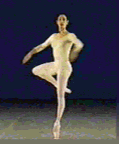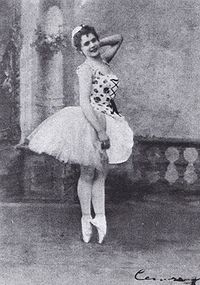
32 fouettés en tournant
Encyclopedia


French language
French is a Romance language spoken as a first language in France, the Romandy region in Switzerland, Wallonia and Brussels in Belgium, Monaco, the regions of Quebec and Acadia in Canada, and by various communities elsewhere. Second-language speakers of French are distributed throughout many parts...
. 32 "turning fouettés") is a movement in classical ballet.
Movement
A fouetté rond de jambe en tournant is an action where the dancer stands momentarily on flat foot with the supporting knee bent as the other "working" leg is whipped around to the side, creating the impetus to spin one turn. The working leg is then pulled in to touch the supporting knee as the dancer rises up en pointeEn pointe
En pointe means "on the tip" and is a part of classical ballet technique, usually practised using specially reinforced shoes called pointe shoes or toe shoes. The technique developed from the desire for dancers to appear weightless and sylph-like and has evolved to enable dancers to dance on the...
on the supporting foot. The ability to consecutively perform 32 of these turns is considered a bravura
Bravura
In classical music, a bravura is a virtuosic passage intended to show off the skill of a performer, generally as a solo, and often in a cadenza. It can also be used as an adjective , or to refer to a performance of extraordinary virtuosity. The term comes from the Italian language for great skill....
step by the ballerina, emphasizing her strength, stamina, and technique. It is a very difficult step to do and many ballerinas can only do 32 on one side, normally the right.
History
32 fouettés were first introduced into the coda of the Grand Pas d'action of the ballet CinderellaCinderella (Fitinhof-Schell)
Cinderella - ballet-féerie in 3 Acts, with choreography by Enrico Cecchetti and Lev Ivanov , with the production being supervised under the counsel and instruction of Marius Petipa. Music by Baron Boris Vietinghoff-Scheel...
(choreographed by Lev Ivanov
Lev Ivanov
Lev Ivanovich Ivanov was a Russian ballet dancer and choreographer and later, Second Balletmaster of the Imperial Ballet....
, Enrico Cecchetti
Enrico Cecchetti
Enrico Cecchetti was an Italian ballet dancer, mime, and founder of the Cecchetti method. The son of two dancers from Civitanova Marche, he was born in the costuming room of the Teatro Tordinona in Rome. After an illustrious career as a dancer in Europe, he went to dance for the Imperial Ballet in...
, and Marius Petipa
Marius Petipa
Victor Marius Alphonse Petipa was a French ballet dancer, teacher and choreographer. Petipa is considered to be the most influential ballet master and choreographer of ballet that has ever lived....
to the music of Baron Boris Vietinghoff-Scheel) by Pierina Legnani
Pierina Legnani
Pierina Legnani was an Italian ballerina, a terre-à-terre virtuosa extraordinaire, considered one of the greatest ballerinas of all time.-Career:...
, Prima Ballerina Assoluta
Prima ballerina assoluta
Prima ballerina assoluta is a rank or title given to notable female ballet dancers. To be recognised as a prima ballerina assoluta is a very rare honour, reserved only for the most exceptional soloists, usually those who have achieved international acclaim....
of the Imperial Ballet
Mariinsky Ballet
The Mariinsky Ballet is a classical ballet company based at the Mariinsky Theatre in Saint Petersburg, Russia. Founded in the 18th century and originally known as the Imperial Russian Ballet, the Mariinsky Ballet is one of the world's leading ballet companies...
of St. Petersburg.
The first Russian ballerina to perform the 32 fouettés was Prima Ballerina Assoluta Mathilde Kschessinskaya.
The ballet historian Konstantin Skalkovsky, who was the dance critic for the St. Petersburg Gazette, attended the premiere of Cinderella. He reported that "...in the last act Legnani positively outdid herself. When Emma Bessone danced the lead in 'The Haarlem Tulip
The Haarlem Tulip
The Haarlem Tulip - Fantastic ballet in 3 Acts-4 Scenes, with choreography by Lev Ivanov and Marius Petipa, and music by Baron Boris Vietinghoff-Scheel....
' she did 14 fouettés. In her variation Legnani performed 32 of them without stopping, and without travelling one inch! The public delightedly applauded the Ballerina and compelled her to repeat this variation as well. On the repetition she nevertheless did 28 fouettés. To count them became the favourite occupation of the public."
Legnani repeated this feat again in many other works during her career with the Imperial Ballet
Mariinsky Ballet
The Mariinsky Ballet is a classical ballet company based at the Mariinsky Theatre in Saint Petersburg, Russia. Founded in the 18th century and originally known as the Imperial Russian Ballet, the Mariinsky Ballet is one of the world's leading ballet companies...
(today the Kirov/Mariinsky Ballet), which lasted from 1893 until 1901. She performed them most notably as Odile in the coda of what is today known as the Black Swan Pas de Deux from Swan Lake
Swan Lake
Swan Lake ballet, op. 20, by Pyotr Tchaikovsky, composed 1875–1876. The scenario, initially in four acts, was fashioned from Russian folk tales and tells the story of Odette, a princess turned into a swan by an evil sorcerer's curse. The choreographer of the original production was Julius Reisinger...
(1895). Today fouetté turns are now required of every Ballerina, and over the course of the 20th century 32 fouettés have been incorporated into the coda of many of the famous Grand Pas.

